| |
| Key events: |
| Chronology: |
|
| History of Serbia |
|---|
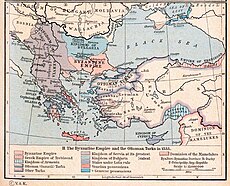 |
Events from the 9th century in, or regarding, Historic Serbia or Serbs .
| |
| Key events: |
| Chronology: |
|
| History of Serbia |
|---|
 |
Events from the 9th century in, or regarding, Historic Serbia or Serbs .
The following, of the Vlastimirović dynasty, ruled Serbia:
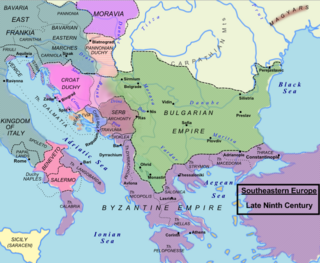
The Principality of Serbia was one of the early medieval states of the Serbs, located in the western regions of Southeastern Europe. It existed from the 8th century up to c. 969–971 and was ruled by the Vlastimirović dynasty. Its first ruler known by name was Višeslav who started ruling around 780. While by that time, starting from the year 680–681, the Bulgarian state had taken the lands to the east. Vlastimir resisted and defeated the Bulgarian army in a three-year-war (839–842), and the two powers lived in peace for some decades. Vlastimir's three sons succeeded in ruling Serbia together, although not for long; Serbia became a key part in the power struggle between the Byzantines and Bulgarians, predominantly allied with the Byzantines, which also resulted in major dynastic wars for a period of three decades. The principality was annexed in 924 by Simeon I and subjected to Bulgarian rule until 933 when Serbian prince Časlav was established as ruler of the Serbian land, becoming the most powerful ruler of the Vlastimirović dynasty.

Presian, sometimes enumerated as Presian I was the khan of Bulgaria in 836–852. He ruled during an extensive expansion in Macedonia.
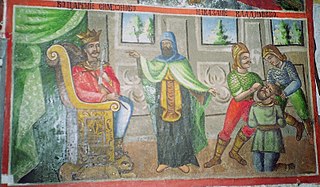
Vladimir-Rasate was the ruler of the First Bulgarian Empire from 889 to 893.

The House of Vlastimirović was the first Serbian royal dynasty, named after Prince Vlastimir, who was recognized by the Byzantine Empire. The dynasty was established with the Unknown Archon, who ruled during the reign of Emperor Heraclius (610–641). The Vlastimirović dynasty ruled in Serbia until the 940s/960s, when some of the Serbian lands were annexed by the Byzantine Empire.

Travunia was a South Slavic medieval principality that was part of Medieval Serbia (850–1371), and later the Medieval Bosnia (1373–1482). The principality became hereditary in a number of noble houses, often kin to the ruling dynasty. The region came under Ottoman rule in 1482. Its seat was in the city of Trebinje.
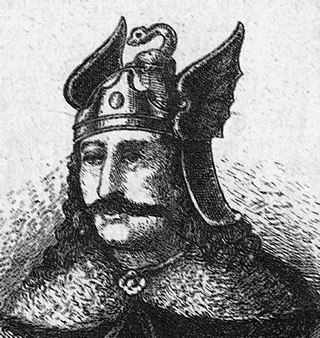
Časlav was Prince of the Serbs from c. 933 until his death in c. 943/960.
Višeslav or Vojislav, is the first Serbian ruler known by name, who ruled in c. 780. Serbia was a Slavic principality, subject to the Byzantine Empire, located in the western Balkans, bordering with Bulgaria in the east. Mentioned in the De Administrando Imperio (DAI) from the mid-10th century, Višeslav was a progenitor of the Serbian ruling family, known in historiography as the Vlastimirović dynasty. He was descended from the unnamed "Serbian prince" who led his people to the Dalmatia province and established hereditary rule under Byzantine suzerainty. The names of Višeslav's predecessors were not included in the DAI. The dynasty ruled the Principality of Serbia from the early 8th century until around 960.
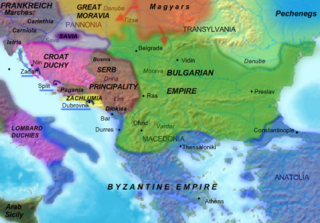
Petar Gojniković or Peter of Serbia was Prince of the Serbs from 892 to 917. He ruled and expanded the First Serbian Principality and won several wars against other family members that sought the crown. He was the first Serbian monarch with a Christian (non-Slavic) name.

Vlastimir was the Serbian prince from c. 830 until c. 851. Little is known of his reign. He held Serbia during the growing threat posed by the neighbouring, hitherto peaceful, First Bulgarian Empire, which had expanded significantly toward Serbia.
Mutimir was prince of the first Serbian Principality from ca. 850 until 891. He defeated the Bulgar army, and allied himself with the Byzantine emperor, and the Church in Serbia with the Ecumenical Patriarchate of Constantinople.

The Bulgarian-Serbian wars were a series of conflicts between the Bulgarian Empire and medieval Serbian states between the 9th and 14th centuries in the central Balkans.
Pribislav was Prince of the Serbs for a year, in 891–892, before being deposed by his cousin Petar. He was the eldest son of Mutimir of the Vlastimirović dynasty, who ruled during the expanding and Christianization of Serbia.

Strojimir was the co-ruler of the Serbian Principality alongside his two brothers Mutimir and Gojnik, from ca 851 to his and Gojnik's deposition in the 880s after an unsuccessful coup against the eldest Prince Mutimir.
Klonimir was a Serbian prince of the Vlastimirović dynasty, and pretender to the throne of the Serbian Principality. His father and uncle, co-princes Strojimir and Gojnik, had been exiled to Bulgaria with their families after their eldest brother Mutimir had ousted them and taken the Serbian throne. Klonimir married a Bulgarian noblewoman chosen by Khan Boris I himself. She later gave birth to a son named Časlav. The descendants of the three Vlastimirović branches continued the feud over the Serbian throne which spanned over the century, and Klonimir returned to Serbia in ca. 896 and attempted to take the country from his cousin Petar, who had ruled since 891. He managed to take over the Serbian city of Destinikon, but the much more powerful Petar defeated him, and it is presumed that Klonimir died in battle. His son Časlav later became the most powerful of the Vlastimirović dynasty, as Prince of Serbia from 927 to 960, unifying several tribes in the region.
Bran Mutimirović was a Serbian prince, son of Serbian ruler Mutimir.

Pavle Branovic was the Prince of the Serbs from 917 to 921. He was put on the throne by the Bulgarian Tsar Symeon I of Bulgaria, who had imprisoned the previous prince, Petar after he had become a Byzantine ally. Pavle ruled for four years, before being defeated by Zaharija Pribislavljević, his cousin. Pavle was the son of Bran, the middle son of Mutimir of the Vlastimirović dynasty.
Krajina Belojević, was the 9th century local Slavic chieftain from the region surrounding Trebinje, who ruled the area with a title of župan., The same region centered on Trebinje, also known as Travunia, was earlier ruled by Krajina's father, the local lord Beloje. At the time of Krajina's rule, the region was still under suzerainty of the Principality of Serbia, and he was in vassal relation to its ruling Vlastimirović's. In 847/848, after the Bulgarian–Serbian War (839–842), victorious Prince Vlastimir of Serbia married his unnamed daughter to Krajina, thus elevating his and his province rank. In doing so his father-in-law, eponymous founder of the Vlastimirović's, dynasty which rule Serbia until 969, granted them independence. Although Krajina's father sought to free himself and his province from Serbian suzerainty, and though Krajina succeeded in achieving that goal through marriage with Vlastimir's daughter, he continued to serve in office as župan under Mutimir. With the Vlastimir's daughter Krajina had a son that would succeed him, Hvalimir. Hvalimir in turn had a son, Čučimir, who was the last known Belojević in charge of Travunia before it was annexed by the Byzantines.

Gojnik Vlastimirović or Gojnik of Serbia was a Serbian Župan who was subject to his elder brother Mutimir, the Grand Župan of the Serbian lands (Rascia) from ca. 850–860 with his brother Strojimir. He was the youngest son of Vlastimir of Serbia, the first independent ruler of Rascia.
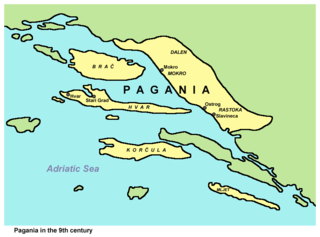
The Narentines were a South Slavic tribe that occupied an area of southern Dalmatia centered at the river Neretva, active in the 9th and 10th centuries, noted as pirates on the Adriatic. Named Narentani in Venetian sources, Greek sources call them Paganoi, "pagans", as they were for long pagan, in a time when neighbouring tribes were Christianized. The tribe were fierce enemies of the Republic of Venice, having attacked Venetian merchants and clergy passing on the Adriatic, and even raided close to Venice itself, as well as defeated the doge several times. Venetian–Narentine peace treaties did not last long, as the Narentines quickly returned to piracy. They were finally defeated in a Venetian crackdown at the turn of the 10th century and disappeared from sources by the 11th century.

The Bulgarian-Serbian War of 853 was fought between the First Bulgarian Empire and the Serbian Principality. It was the second conflict of the medieval Bulgarian–Serbian Wars.
...the Serbs, a people that is said to hold a large part of Dalmatia
...who are said to hold a great part of Dalmatia
'a people that is said to hold a large part of Dalmatia'. This was a reference to the ancient Roman province of Dalmatia, which extended deep into the western Balkan interior, from the eastern Adriatic coast to the valleys of the Ibar and Sava Rivers.